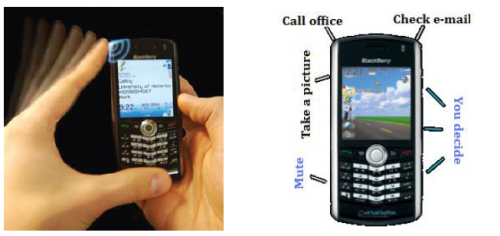If you would like to see more information on this case study, click here!
You can request this case study and a WCDE staff member will get back to you.
Virtual Button® technology has been developed by VBT Innovations Inc. a high tech company located and established in Waterloo, Ontario, Canada in 2008. Virtual Buttons® are meant to augment or replace mechanical buttons and capacitive touch screens on consumer electronics devices such as cell phones. This technology enables buttons to be placed on flat and curved surfaces, edges, and locations where a mechanical button is not feasible. Figure 1 shows an example of a Virtual Button® application for a cell phone tapping user interface. Virtual Button® offers multiple advantages as it can endure harsh environments with high level of shock, vibration, and humidity. It can be also suitable for sensitive environments as the technology enables buttons to be placed on any existing surface, offering design flexibility. Since there is no direct connection between the sensor inside the device and its exterior; the Virtual Buttons® is safe for steam chambers and ethylene oxide cleaning as well. One of the enabling technologies of this system is the Micro Electro Mechanical System (MEMS) accelerometer. This accelerometer must be designed and fabricated to meet the special requirements of VBT Innovations Inc.

Any location can be a button using virtual button technology
This case study is intended to have students exposed to MEMS and allow students to design a fabrication method using PolyMUMPs for a MEMS device with already optimized device geometry and provided device performance requirements and fabrication constraints. At the end of this case study, students will be able to discuss the concept of MEMS devices and fabrication processes, and generate a MEMS mask (layout) for a given fabrication process.
If you would like to see more information on this case study, click here!
You can request this case study and a WCDE staff member will get back to you.
Contact Waterloo Cases in Design Engineering
Steve Lambert
Tel: (519) 888-4728
Email: steve@uwaterloo.ca
The University of Waterloo acknowledges that much of our work takes place on the traditional territory of the Neutral, Anishinaabeg and Haudenosaunee peoples. Our main campus is situated on the Haldimand Tract, the land granted to the Six Nations that includes six miles on each side of the Grand River. Our active work toward reconciliation takes place across our campuses through research, learning, teaching, and community building, and is co-ordinated within the Office of Indigenous Relations.